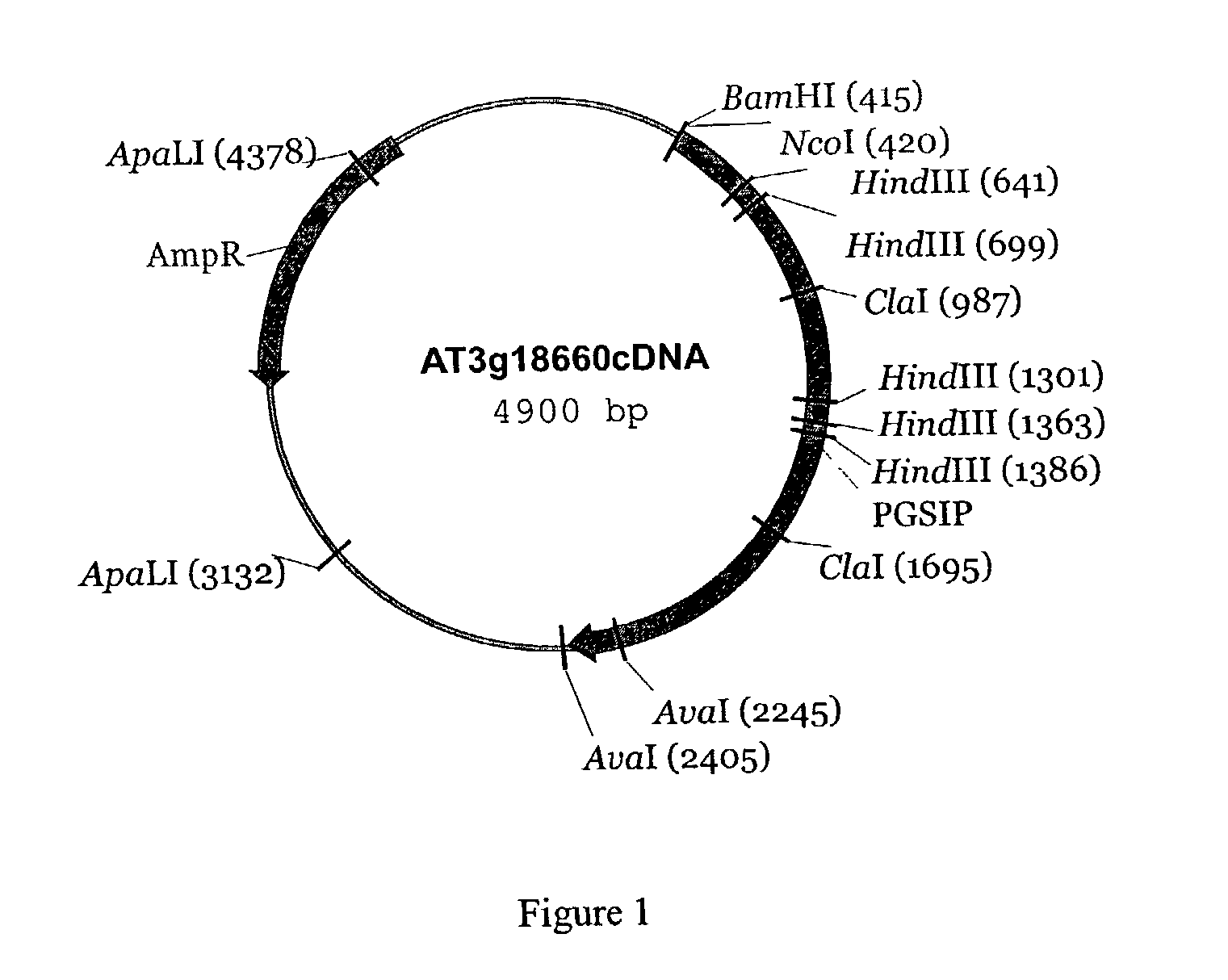Starch modification
a technology of starch and starch priming, which is applied in the field of starch modification, can solve the problems of inability to synthesise glycogen, no one has identified and demonstrated a functional protein for starch initiation or starch priming in plants, and the physical properties of unmodified starch limit its usefulness in many applications
- Summary
- Abstract
- Description
- Claims
- Application Information
AI Technical Summary
Benefits of technology
Problems solved by technology
Method used
Image
Examples
example 1
Identification of Plant Glycogenin-Like Gene Homologues in Arabidopsis
[0203] Arabidopsis nucleic acid molecules showing similarities to yeast glycogenin genes were identified by sequence analysis. The sequence analysis programs used in the following examples are from the Wisconsin Package of computer programs (Deveraux et al., Nucl. Acids Res. 12: 387 (1984); available from Genetics Computer Group, Madison, Wis.). ESTs and genes were identified using the program BLAST (Basic Local Alignment Search Tool; Altschul, S. F. et al (1990) J. Mol. Biol. 215:403-410, see also www.ncbi.nlm.nih.gov / BLAST / ).
[0204] The sequence comparison and identification program tblastx was used with the yeast glycogenin 1 (Glg1) gene (GenBank:U25546, Swiss_Prot (SP):P36143) to search against the Arabidopsis sequences collected in an in-house database comprising published plant sequences. A number of hits to this gene were obtained. One of the hits was identified as EMBL:AC004260 version GI:2957150 which was ...
example 2
Isolation of cDNA Encoding A. thaliana Glycogenin Homologue
[0212] Primers were designed to clone a full length cDNA representing the accession number AB026654, gene_id:MVE11.2 (at3g18660 (MIPS)) from an Arabidopsis thaliana cDNA pool. Sequencing the full length clone indicated that the gene encoded a protein of 659 amino-acids and consists of five exons. The cDNA sequence designated as SEQ ID NO: 2.
[0213] Arabidopsis thaliana was grown in growth cabinets with a 16 hours light and 8 hours dark period at a temperature of 22.degree. C. during the day and 17.degree. C. during the night. A mixed cDNA sample was made with total RNA from 10 different tissues mixed together in equal amounts: root, dividing cell culture, young leaf, mature leaf, stem, seedling, seed, flower buds+flowers, drought 6 days- and drought 10 days-subjected plants.
[0214] The primer used to make the first strand cDNA using Superscript II was from the original paper on PCR amplification by (Frohman et al. (1988) Proc....
example 3
Functional Analysis of the Arabidopsis cDNA
[0219] Yeast contains two glycogenin genes Glg1 (YKROS8w) and Glg2 (YJL137c). Double mutants in the above genes do not make any glycogen (Cheng et al (1995) Mol. and Cell Biology 15(12):6632-6640). Mutant yeast strains from the EUROSCARF (European Saccharomyces Cerevisiae ARchives For Functional Analysis) collection were obtained from SRD GmbH, D61440, Germany along with the wild type. Single mutants in the Glg1 and Glg2 genes were obtained in addition to the double mutant. Additionally a plasmid containing the entire Glg2 ORF including the promoter was also obtained. This plasmid was used as a positive control to establish a complementation assay. The description of the strains are:
6 Wild type ORF Accession no. Strain Genotype Y00000 BY4741 MATa; his3.DELTA.1; leu2.DELTA.0; met15.DELTA.0; ura3.DELTA.0
[0220] Single Mutants:
7 ORF Accession no. Strain Genotype YKR058W Y15129 G1G1 mutant BY4742; Mat alpha; his3.DELTA.1; leu2.DELTA.0; ura3.DELT...
PUM
| Property | Measurement | Unit |
|---|---|---|
| diameter | aaaaa | aaaaa |
| diameter | aaaaa | aaaaa |
| diameter | aaaaa | aaaaa |
Abstract
Description
Claims
Application Information
 Login to View More
Login to View More - R&D
- Intellectual Property
- Life Sciences
- Materials
- Tech Scout
- Unparalleled Data Quality
- Higher Quality Content
- 60% Fewer Hallucinations
Browse by: Latest US Patents, China's latest patents, Technical Efficacy Thesaurus, Application Domain, Technology Topic, Popular Technical Reports.
© 2025 PatSnap. All rights reserved.Legal|Privacy policy|Modern Slavery Act Transparency Statement|Sitemap|About US| Contact US: help@patsnap.com



